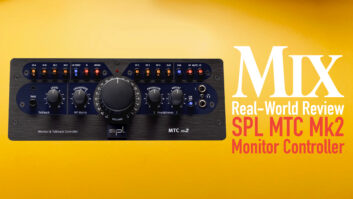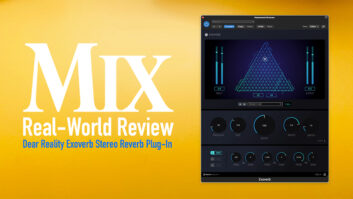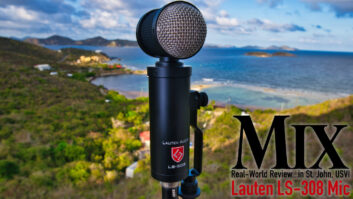Clubhouse Studios (Rhinebeck, NY) engineer/producer Neil Dorfsman and owner/engineer Paul Antonel put up an AEA R88 mk2 stereo ribbon microphone on drummer Ray Levier’s kit. We were going for a big, wide, powerful drum sound, and they placed the mic about 6 feet from the kit and about 5 feet high, running it through two channels of 31102s, from a Neve 8068. As the R88 is a passive stereo ribbon mic with both elements fixed at 90 degrees in one housing, it can be used for both XY and MS recording. It features two 2.35-inch x 0.185-inch, 2-micron pure aluminum ribbon elements—the same as the ones in AEA’s classic R44 ribbon mic. The frequency response has the HF roll-off characteristic of all ribbon mic elements, in this case down some -10 dB at 18 kHz. According to AEA, the R88 can handle up to 165 dB of SPL—a lot for any mic. [As with all ribbon mics, max SPL handling is reduced at lower frequencies. AEA confirms that this spec is for signal above 1 kHz; the max levels drop 6 dB per octave below 1 kHz—ed.] With its black, textured paint (reminiscent of the Coles 4038), it’s a big, classic-looking mic, clocking in at over 15 inches tall, but wow—it does sound fantastic in a room!
Panning the mic hard left and right in the mix, it delivers a well-balanced smooth sound, the soft sponginess of a ribbon and a beautiful stereo image. It can take compression well, too; when I hit it with some 1176 compression, it made the drums explode. Tucked into the mix, I found no need for reverb, letting the R88 do the job naturally. A superb mic all around, I highly recommend it.
[PAR Tech Editor Lynn Fuston adds: I’ve used the R88 in XY and MS, and its siblings, a pair of R84s, as string overheads when doing large string sections (10 to 24 pieces) and it’s amazing how well it captures a well-balanced image and a big film score sound, even in less than ideal spaces. Very smooth and rich.”]
Small Amp, Big Sound
While I’m on the topic of the Dorfsman session, one of the amps I used for the guitars was my 1947 Gibson BR6. This little amp runs around 11 W and features five tubes including a 6V6 pair. It uses a small 10-inch field coil Electro Magnetic Dynamic moving coil speaker and no controls but a volume knob.
There’s one thing for sure when it comes to recording guitars: You don’t always need big amps for big sound. By using a touch of Tube Screamer and a Creation Audio Labs’ Holy Fire for clean input gain, this thing is a tone monster. Found for $250 and restocked with fresh tubes by my friend Vincent Miragila of Analog Design Group, it looks like a small radio from the 40s— but it’s much more.
Neil Dorfsman used a Heil PR-30 and a Shure SM7B mic on the amp through the aforementioned Neve modules. I played a Fender Broadcaster through it in open D tuning, as well as a four-string Cigar Box tuned to AAGG. Both the Heil PR-30—a large diaphragm dynamic mic with a 40 Hz to 18 kHz frequency response—and the SM7B—a classic dynamic mic with switchable bass rolloff and presence boost—sound really great on guitar tracks. You can put them right on the cabinet and they will deliver a thick and creamy but present sound, especially when mixed together.
Rich Tozzoli is an award-winning, Grammy-nominated producer, engineer and composer for programming such as FOX NFL, Pawn Stars, Duck Dynasty and Oprah & Deepak Chopra. richtozzoli.com.







